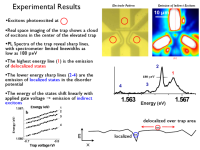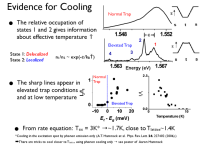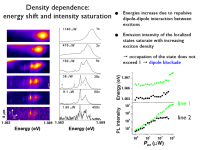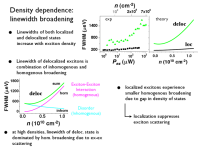Attractive and repulsive dipolar interaction in bilayers of indirect excitons |
|
|
|
We explore attractive dipolar interaction in indirect excitons (IXs). For one layer of IXs in a single pair of coupled quantum wells (CQW), the out-of-plane IX electric dipoles lead to repulsive dipolar interaction between IXs. The attractive dipolar interaction between IXs is realized in a 2-CQW heterostructure with two IX layers in two separated CQW pairs. We found both in experimental measurements and theoretical simulations that increasing density of IXs in one layer causes a monotonic energy reduction for IXs in the other layer. We also found an in-plane shift of a cloud of IXs in one layer towards a cloud of IXs in the other layer. This behaviour is qualitatively consistent with attractive dipolar interaction. The measured IX energy reduction and IX cloud shift are higher than the values given by the correlated liquid theory. D. J. Choksy, Chao Xu, M. M. Fogler, L. V. Butov, J. Norman, and A. C. Gossard, Attractive and repulsive dipolar interaction in bilayers of indirect excitons lattices, arXiv:2011.06084 (2020) , Phys. Rev. B 103, 045126 (2021). |
Measurement of exciton correlations using electrostatic lattices |
|

|
We present a method for determining correlations in a gas of indirect excitons in a semiconductor quantum well structure. The method involves subjecting the excitons to a periodic electrostatic potential that causes modulations of the exciton density and photoluminescence (PL). Experimentally measured amplitudes of energy and intensity modulations of exciton PL serve as an input to a theoretical estimate of the exciton correlation parameter and temperature. We also present a proof-of-principle demonstration of the method for determining the correlation parameter and discuss how its accuracy can be improved. M. Remeika, J. R. Leonard, C. J. Dorow, M. M. Fogler, L. V. Butov, M. Hanson, and A. C. Gossard, Measurement of exciton correlations using electrostatic lattices, arXiv:1508.04407v1 (2015), Phys. Rev. B 92, 115311 (2015). |
Effect of exciton-exciton interaction on localized and delocalized exciton states |
|
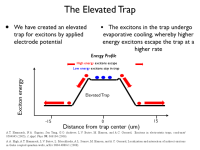
|
We introduced an elevated trap technique and exploited it for lowering the effective temperature of indirect excitons. We observed narrow photoluminescence lines, which correspond to the emission of individual states of indirect excitons in a disorder potential. We studied the effect of exciton-exciton interaction on the localized and delocalized exciton states and found that the homogeneous line broadening increases with density and dominates the linewidth at high densities. A.A. High, A.T. Hammack, L.V. Butov, L. Mouchliadis, A.L. Ivanov, M. Hanson, and A.C. Gossard, Indirect excitons in elevated traps, arXiv:0804.4886v1 (2008); Nano Lett., 9 (5), 2094 - 2098 (2009). |
Repulsive interaction between indirect excitons |
|

|
Indirect excitons are dipoles oriented perpendicular to the QW plane and an interaction between them is repulsive. The interaction-induced energy shift allows estimation of the density of indirect excitons. The repulsive interaction between the indirect excitons is advantageous for the exciton condensation: It stabilizes exciton state against formation of exciton molecules or metallic electron-hole droplets, increases the critical temperature for BEC, and results in a screening of an in-plane disorder potential. L.V. Butov, A. Zrenner, G. Bohm, G. Weimann, Condensation of indirect excitons in coupled AlAs/GaAs quantum wells, J. de Physique 3, 167 (1993). L.V. Butov, A. Zrenner, G. Abstreiter, G. Bohm, G. Weimann, Condensation of indirect excitons in coupled AlAs/GaAs quantum wells, Phys. Rev. Lett. 73, 304 (1994). L.V. Butov, A.A. Shashkin, V.T. Dolgopolov, K.L. Campman, and A.C. Gossard, Magneto-optics of the spatially separated electron and hole layers in GaAs/AlGaAs coupled quantum wells, Phys. Rev. B 60, 8753 (1999). L.V. Butov, A. Imamoglu, K.L. Campman, and A.C. Gossard, Coulomb effects in spatially separated electron and hole layers in coupled quantum wells, Zh. Eksp. Teor. Fiz. 119, 301 (2001) [JETP 92, 260 (2001)]. |


